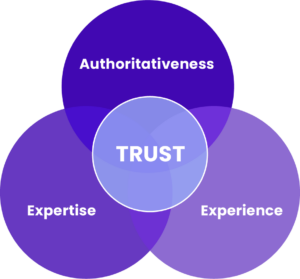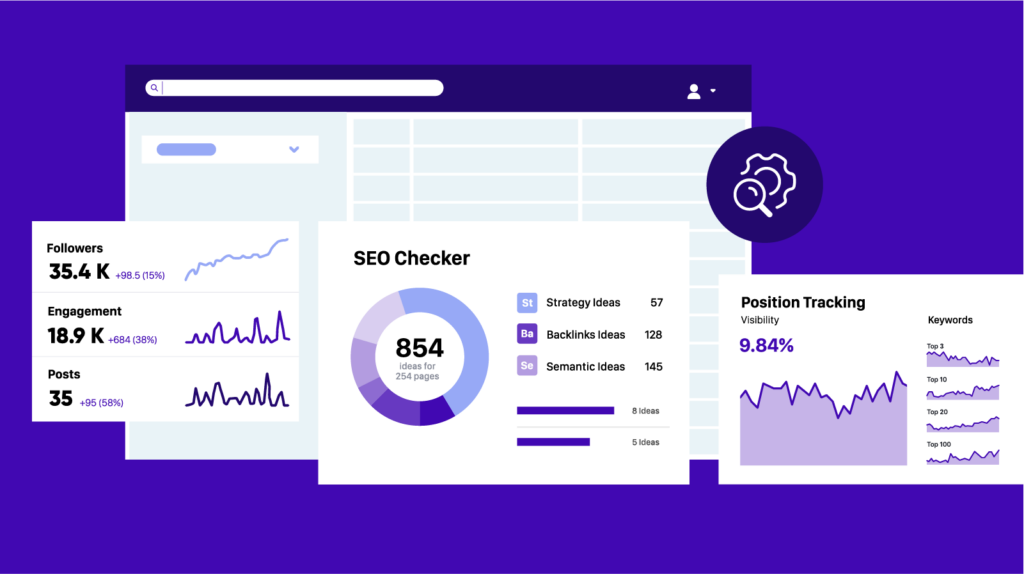Learn the keys to driving relevant organic traffic in the modern B2B search landscape.
Search engine optimization is integral to any organization’s digital marketing success. When done well, this practice can efficiently deliver a steady and sustained stream of relevant traffic to your website and digital assets.
In the realm of B2B marketing, where buyers and decision makers are frequently searching for information to guide their purchase journeys, high-performing SEO can be especially valuable. But make no mistake: building and maintaining a successful SEO strategy is a complex and nuanced process.
Read on to learn all about B2B search engine optimization with insights and guidance from our expert team.
Learn more about how TopRank Marketing can elevate your SEO strategy .
What is B2B search engine optimization?
Search engine optimization (SEO) is an approach that aims to improve a website’s visibility in search engine result pages (SERPs) for strategically defined keywords and phrases. SEO is a wide-ranging discipline that involves many tactics and techniques, but it all starts with data-driven keyword planning.
The ultimate goal of SEO is to drive organic (non-paid) traffic to a website and build a company’s digital authority.
B2B search engine optimization refers to the specific use of this strategy for B2B (business-to-business) marketing. Compared to B2C search engine marketing, this category of SEO has some unique characteristics.

B2B SEO vs. B2C SEO
While they share a core objective – optimizing web content for discoverability in search – B2B SEO and B2C SEO are different in many key ways. This is because the nature of researching and purchasing B2B solutions is drastically different from the way we buy consumer goods.
Compared to B2C strategies, B2B search engine optimization tends to focus more on audience targeting, thought leadership, and generating and nurturing leads. There is typically less of an emphasis on e-commerce, or converting customers directly from a web page.

On-page SEO vs. off-page SEO
SEO strategies typically account for two forms of optimization: on-page and off-page.
On-page SEO refers to all activities taking place on the website you’re optimizing itself. This can include content, meta descriptions and tags, URL structure, headers, and more.
Off-page SEO refers to all factors outside of the website that can still affect its ranking and performance. These include backlinks, social/influencer signals, corporate reputation, and more.
Both on-page and off-page SEO should be accounted for in your strategy.
Why is organic traffic valuable to B2B companies?
Before we start unpacking how to create a B2B SEO strategy, first it’s important to understand why SEO investments matter so much. Organic traffic , which refers to visitors drawn to your website through unpaid search results, is gold for B2B companies.
Simply put, increasing organic traffic means exposing more people to your brand and its solutions.
Organic search is responsible for 53% of all website traffic .
Here are some key benefits of treating organic traffic as a primary KPI in your B2B marketing strategy:
- Sustained results: Unlike paid traffic (e.g. Google Ads), which stops when your ad budget runs out, organic traffic is sustainable and can provide a consistent flow of visitors to your website over the long term.
- Cost effectiveness: While achieving and maintaining high organic rankings does require investment, once you’ve established a strong online presence, organic traffic becomes a very cost-effective way to drive visitors and leads.
- Trust and credibility: Rankings in Google are meant to reflect real-world authority, by design. When your brand shows up high in the results for their search, it demonstrates credibility and relevance.
- Higher click-through rates: Research has found that the CTR of organic results is nearly 20x the CTR of paid results.
- Fortifying your brand’s topical authority: Creating focused content around specific topics can build your website’s topical authority , helping shape your brand’s perception as a subject matter expert in the eyes of search engines and users alike.
- Quality leads: Because they are actively searching for information relevant to your products or services, organic visitors tend to be more qualified and engaged. Delivering quality content that meets their intent delivers a good brand experience that builds trust.
Read more on our blog: Why Intent-Qualified Organic Traffic Will Power the Future of B2B Marketing
Developing a B2B search engine optimization strategy
Building a successful SEO strategy in B2B marketing begins with defining goals, and ends… well, never. Continually evolving and refining your approach based on results and analysis is how the game is played. The following framework will get your SEO strategy to a good place.
1. Define goals and search KPIs
What are you seeking to accomplish with your SEO strategy? At a high level, the answer is usually increasing organic traffic in the name of driving business growth, but there is plenty of room to get more specific.
Metrics like click-through rate, keyword rankings, dwell time, conversion rate, and crawl errors are among the examples of ways to measure the impact of your SEO efforts. Select key performance indicators (KPIs) that align with your overarching goals and track them continually.
2. Conduct SEO research
This is a vital step that deserves plenty of attention and consideration. SEO research informed by quality data and expert analysis will lay the groundwork for a successful program. Recommended components of this process include:
- Keyword research
- Audience research
- Competitive analysis
3. Complete an SEO audit of your website
Before you start moving forward on your SEO strategy, it’s important to get a clear handle on what you’re already working with. An SEO audit will reveal strengths and weaknesses of your current website from a search standpoint, while highlighting key opportunities to make gains and set your focus.
4. Develop an SEO content strategy
Content is the lifeblood of SEO. Aligning your content planning and publishing with your SEO strategy is crucial for ensuring your work is primed to perform and drive results.
B2B content strategies are often organized by pillars, which compartmentalize topics based on categories relevant to the business. At TopRank Marketing, we use this model to build topical authority around key solution-related areas for the brand.
Read more on our blog: Intent-Based Strategy Is the Future of SEO
5. Perform on-page and technical optimizations
While developing helpful and high-quality content is essential to strong SEO performance, there are certain on-page and technical factors that will help search engines find, understand, and contextualize your content. These factors include everything from semantic keywords and headers in the copy to page-load speed and schema markups on the back end.
6. Implement a link-building strategy
Acquiring backlinks from authoritative sources, as well as utilizing internal linking with relevant content on your own website, will help your content rank. Make sure this is part of your SEO planning.
7. Measurement and analytics
SEO is a discipline that epitomizes the old saying, “Change is the only constant.” The ever-evolving nature of search algorithms and user behaviors means you need to remain vigilant, with a constant eye on traffic and trends.
8. SEO reporting
In addition to measuring performance for the purpose of optimization and improvement, it’s also important to measure and share results for the purpose of reporting. Marketers need to showcase the impact of their SEO strategy across the organization to drive continued alignment and investment.

How to create content that’s optimized for search
Traditionally, there have been many different shortcuts and “hacks” proposed for succeeding in search. Keyword stuffing, backlink farming, and black hat SEO tactics were once common, and sadly were actually effective.
But underhanded tactics don’t work as well anymore. Google and other search engines have become adept at recognizing and ranking content that is helpful to readers and directly addresses the search intent for a given query.
As Google’s Public Liaison for Search Danny Sullivan explained in 2022 when the engine unveiled its “helpful content update”:
“Many of us have experienced the frustration of visiting a web page that seems like it has what we’re looking for, but doesn’t live up to our expectations. The content might not have the insights you want, or it may not even seem like it was created for, or even by, a person. We work hard to make sure the pages we show on Search are as helpful and relevant as possible .”
As Sullivan’s explanation alludes, Google is increasingly focused on prioritizing original, useful, human content. This means that low-quality, irrelevant, or AI-produced material is likely to struggle in search.
Creating B2B content that’s optimized for search in the modern marketing landscape requires skilled creators with a strong understanding of the target audience, their search intent, and how the brand can best meet that intent through their experience, expertise, and authority.
E-E-A-T: Google’s Primary Ranking Influencers
- Experience
- Expertise
- Authority
- Trust

Placing search intent at the heart of your SEO strategy
At TopRank Marketing, search intent is central to our philosophy on B2B SEO. We define search intent simply as the reason why a user types a query into a search engine. The intent behind a search can be informational, navigational, transactional, or commercial.
Understanding and meeting the search intent behind keywords is key to winning rankings. Meanwhile, using search intent as the guiding light for your keyword planning and content planning helps ensure you are attracting relevant users with problems you can help solve.
Learn more in our guide: Marketing with Intent: The Future of SEO and Qualified B2B Traffic
Types of SEO used in B2B marketing
A wide range of different styles and types of SEO are used as part of B2B marketing strategies. These include:
- On-page SEO
- Off-page SEO
- Technical SEO
- Local SEO
- Global SEO
- Enterprise SEO
- Video SEO
- Mobile SEO
The mix of SEO tactics used by B2B brands is dictated by their overall strategy and business goals. All can be effective for specific purposes.
Read more on our blog: 5 Tips for Empowering Enterprise SEO Success
How to measure the impact of your B2B SEO campaigns
There’s a misconception that SEO impact is difficult to measure, or to connect to revenue. That’s not really true. There are a variety of metrics and KPIs that can be used to measure your SEO success and continually improve your results.
Metrics for measuring B2B SEO:
- Organic traffic
- Leads sourced from organic search
- Lead quality and conversion rate (compare to paid and other channels)
- Keyword rankings
- Content engagement – CTR, pages/session, and dwell time
- Competitive analysis (compare rankings and trends to competitors)
- Customer lifetime value
- Return on investment
Aggregated website traffic data ranks among the most robust and transparent sources of information marketers can access. As data privacy guidelines move forward, and tracking cookies disappear, this first-party data becomes all the more valuable.
A well-executed SEO strategy can become your most trusted source of actionable marketing insight. We’ve seen this happen with countless clients, and with our own agency as well.
Tracking success and results with a keyword glossary
There is no shortage of methods and tools marketers use to track and analyze SEO performance. Actionable SEO reporting should include a running list of all tracked target keywords in your strategy, including the following for each:
- Keyword volume, difficulty, CPC
- Content pillar
- Search intent
- Funnel stage
- Currently ranking URLs
- Competitor rankings
- SERP features
- Last optimization date
At TopRank Marketing, we power our search content programs with keyword glossaries . These shared client documents offer a real-time view of important keyword data, which can be endlessly segmented and analyzed. Keyword glossaries make it easy to stay on top of performance, spot opportunities, and constantly improve.

B2B search engine optimization resources
Search engine optimization is an inherently challenging strategy for B2B companies to master. The nature of web search – complex and constantly in flux – requires a rigorous and expert-led discipline to drive exceptional results.
These authoritative online resources can help keep you up to speed on the latest and most effective SEO techniques:
And of course, the TopRank Marketing Blog , which frequently covers topics relating to the evolution of SEO and important new considerations such as Google Analytics 4, AI, algorithm changes, and more.
